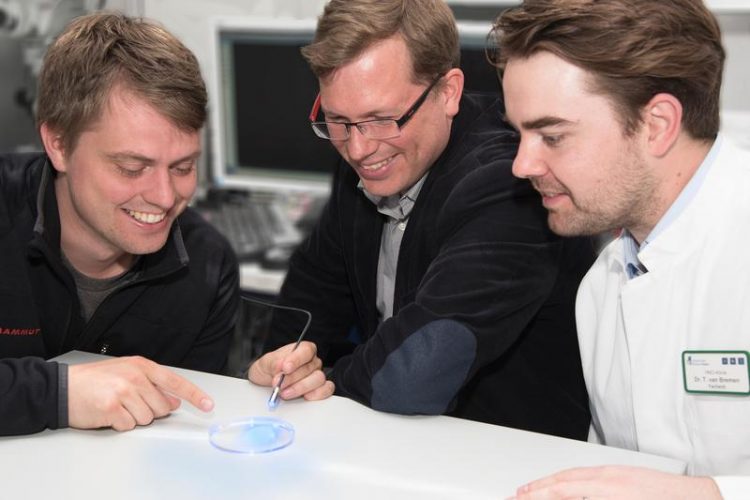Researchers from the University Bonn Stimulate Larynx Muscles With Light

Dr. Tobias Bruegmann, Dr. Philipp Sasse and Dr. Tobias van Bremen (from left) use an optical fiber to demonstrate the functional principle. Photo: Claudia Siebenhuener/University Hospital Bonn
Muscles respond to nerve stimulation by contracting. Normally, light cannot be used to initiate these contractions. Several years ago, however, an exotic group of molecules known as Channelrhodopsins was discovered in green algae.
Channelrhodopsins are ion channels that open when illuminated. When channelrhodopsins are appropriately packaged and injected into a muscle, they are integrating into individual muscle cells. As soon as these cells are exposed to light, the channels open and positively charged ions flow into the muscle cell, which then contracts.
This functional principle was discovered several years ago. In 2010, the Bonn-based working group used the same method to stimulate the heart in mice. However, laryngeal muscles are part of the skeletal musculature, “and skeletal muscles follow different rules,” says the head of the study, Dr. Philipp Sasse.
For instance, each fiber in a skeletal muscle can contract separately, which allows to control movements as well as muscle strength very precisely. In addition, unlike heart muscle, skeletal muscles can perform static contractions if they are repeatedly stimulated at high frequency.
“For the first time, we have been able to show that light pulses can also create static contractions,” says Dr. Tobias Bruegmann, the first author on the study. “Depending on where we point the light beam, we can also stimulate individual muscle groups – exactly the same way the body does it through the nerves.”
New treatment options
As a result, this method may point the way to new treatment approaches. In a few years, for instance, people with laryngeal paralysis could benefit from it. Laryngeal paralysis can occur after thyroid operations, and during other pathological processes that affect the laryngeal nerves.
The larynx plays an important role in speaking and swallowing, but most importantly in breathing: when you breathe, the muscles of the larynx pull the vocal cords apart so that air can flow into the lungs. In the event of complete paralysis, the patient can no longer breathe.
Unfortunately, electrical stimulators are little effective in restoring larynx function, “because there are different muscles with opposite function close together,” explains Dr. Tobias van Bremen, an ear, nose and throat doctor and one of the co-authors of the study.
“It is almost impossible to stimulate these muscles individually using electrodes.” The light method is a promising approach. The Bonn researchers have already shown that it works in animals – they were able to use light to open the air passage in the larynges of mice. However, several technical hurdles have to be overcome, such as bringing the Channelrhodopsin into the larynx musculature. The researchers in Bonn are currently testing gene transfer techniques and also optical stimulators.
Publication: Tobias Bruegmann, Tobias van Bremen, Christoph C. Vogt, Thorsten Send, Bernd K. Fleischmann & Philipp Sasse: Optogenetic control of contractile function in skeletal muscle; Nature Communications, date, DOI: 10.1038/ncomms8153
Media contacts:
Dr. Philipp Sasse
Institut für Physiologie I, Universität Bonn
Tel. ++49(0)228-6885212
Email: philipp.sasse@uni-bonn.de
Dr. Tobias Bruegmann
Institut für Physiologie I, Universität Bonn
Tel. ++49(0)228-6885217
Email: tbruegmann@uni-bonn.de
Dr. Tobias van Bremen
Klinik und Poliklinik für Hals-Nasen-Ohrenheilkunde/Chirurgie
Universitätsklinikum Bonn
Tel. ++49(0)228-28715556
Email: Tobias.Vanbremen@ukb.uni-bonn.de
Media Contact
More Information:
http://www.uni-bonn.de/All latest news from the category: Health and Medicine
This subject area encompasses research and studies in the field of human medicine.
Among the wide-ranging list of topics covered here are anesthesiology, anatomy, surgery, human genetics, hygiene and environmental medicine, internal medicine, neurology, pharmacology, physiology, urology and dental medicine.
Newest articles

High-energy-density aqueous battery based on halogen multi-electron transfer
Traditional non-aqueous lithium-ion batteries have a high energy density, but their safety is compromised due to the flammable organic electrolytes they utilize. Aqueous batteries use water as the solvent for…

First-ever combined heart pump and pig kidney transplant
…gives new hope to patient with terminal illness. Surgeons at NYU Langone Health performed the first-ever combined mechanical heart pump and gene-edited pig kidney transplant surgery in a 54-year-old woman…

Biophysics: Testing how well biomarkers work
LMU researchers have developed a method to determine how reliably target proteins can be labeled using super-resolution fluorescence microscopy. Modern microscopy techniques make it possible to examine the inner workings…





















